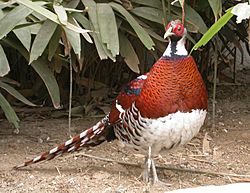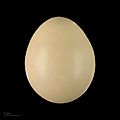Elliot's Pheasant facts for kids
Quick facts for kids Elliot's pheasant |
|
|---|---|
 |
|
| Conservation status | |
| Scientific classification | |
| Kingdom: | |
| Class: | |
| Order: | |
| Family: | |
| Genus: |
Syrmaticus
|
| Binomial name | |
| Syrmaticus ellioti (Swinhoe, 1872)
|
|
The Elliot's pheasant (scientific name: Syrmaticus ellioti) is a beautiful and somewhat large pheasant. It lives naturally in the forests of southeastern China. This bird is known for its stunning feathers and shy nature.
Contents
About Elliot's Pheasant
Elliot's pheasant was first described in 1872 by Robert Swinhoe. It is named after Daniel Giraud Elliot, an American zoologist. These pheasants are part of the Syrmaticus genus, which includes several other long-tailed pheasants.
What Does It Look Like?
Elliot's pheasants are truly eye-catching birds. The males are especially colorful. They have bright white bellies and chests, with a mix of chestnut brown and black feathers on their backs. Their wings often show hints of blue and green. A special feature is their long, banded tail, which has stripes of chestnut and white. Males also have a red patch of skin around their eyes.
Female Elliot's pheasants are less colorful than the males, which is common in many bird species. They have a more muted brown and grey plumage, which helps them blend into their surroundings. This camouflage is important for protecting themselves and their nests from predators.
Where Do They Live?
Elliot's pheasants are native to a specific region in southeastern China. They prefer to live in dense forests, often in mountainous areas. These birds can be found in evergreen and broadleaf forests at different elevations. They like places with thick undergrowth where they can hide and find food.
What Do They Eat?
These pheasants are omnivores, meaning they eat both plants and small animals. Their diet mainly consists of seeds, berries, leaves, and roots that they find on the forest floor. They also enjoy eating insects, worms, and other small invertebrates. They use their strong beaks and claws to scratch around in the leaf litter to find their meals.
Life Cycle and Behavior
Elliot's pheasants are generally shy birds. They spend most of their time on the ground, foraging for food. When they feel threatened, they prefer to run and hide rather than fly. However, they can fly short distances if needed, especially to roost in trees at night.
During the breeding season, usually in spring, the male pheasant will try to attract a female with his colorful display. The female builds a nest on the ground, often hidden among thick plants. She lays a clutch of eggs, which she incubates until they hatch. The young chicks are able to walk and find food shortly after hatching, but they stay with their mother for protection.
Conservation Status
The Elliot's pheasant is currently listed as "Near Threatened" by the International Union for Conservation of Nature (IUCN). This means that while they are not in immediate danger, their numbers are decreasing. The main threats to these beautiful birds are habitat loss due to deforestation and illegal hunting. Efforts are being made to protect their forest homes and ensure their survival for future generations.
Images for kids
See also
 In Spanish: Faisán de Elliot para niños
In Spanish: Faisán de Elliot para niños



